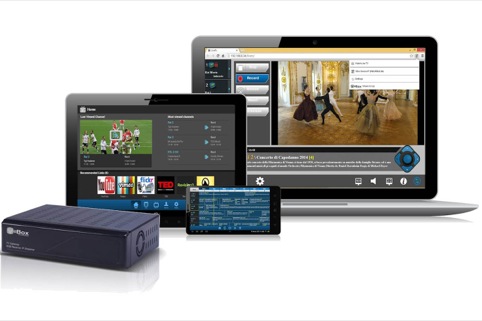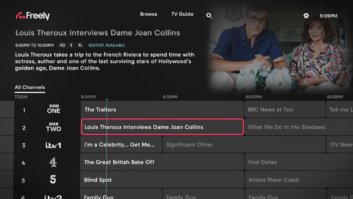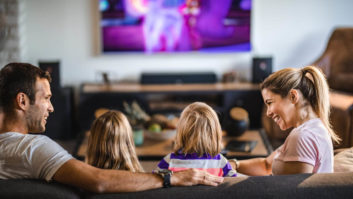
Just days before IBC2014, VBox Communications introduced the new TV Gateway, a device that receives DVB-T2 high-definition broadcast quality TV signal and streams it over a home network to any networked device. The new TV Gateway is one of a range of products from the Israeli company, and, it claims, the first on the market capable of streaming from DVB-T2, enabling HDTV services such as Freeview HD in the UK, Teletene in Belgium, and Digitale Terrestre in Italy.
Amir Aharonovitch (pictured), VP of marketing for VBox Communications, spoke with Holly Ashford about the new system, and changing trends in TV consumption.
VBox Communications was established in 2001 with a focus on developing broadcast equipment and with a “main goal”, explains Aharonovitch, “of converting broadcast signal into IP and then streaming it over a network.” Over the last year, however, the company has honed in on consumer products, “downscaling existing models to consumer-grade products.” VBox identified issues with broadcast television OTT services and aimed to address them by creating a range of devices to “bring about the future of television.”
Broadcasters are facing the issue of “bringing the television signal to multiple screens, different screens, multiple numbers of users and as well as multiple room set-ups,” asserts Aharonovitch. A TV can be connected to a set-top box, yet this limits a user’s consumption to a single screen, and moving to a different room to watch on another screen entails running a cable through the house. “There are some companies which are trying to work around it but there is no one holistic solution,” says Aharonovitch, “and that’s one of the things we’re trying to address.”
The use of “multiple screens, different screens” is increasing: Kantar Media’s syndicated study, futurePROOF revealed earlier this year that forty five per cent of all UK adults now have a tablet compared to 32 per cent a year ago, and 36 per cent at the end of 2013. The highest penetration is among 35-44 year-olds where 58 per cent of adults now have at least one tablet in their home.
VBox’s solution to these issues is, TV Gateway, which “connects directly to the TV source, whether its satellite dish or cable or antenna, and from that it converts the signal over to IP” and simultaneously streams multiple broadcast TV channels across the home network to any connected device – including the increasingly-popular tablet. Additionally, the Gateway serves as a whole-house-DVR/PVR and allows users to record live HDTV on removable or network storage.
The device offers the user two advantages: “you don’t alter the quality of the television signal, whether its full HD or SD channel, and we give you the advantage of IP television in the consumer home.” Aharonovitch asserts that the company has levelled the playing field for the end-user, giving them benefit of tapping into the TV from any device in the home, whether from an OTT service or broadcaster.
The XTi VBox TV Gateway line of products enables broadcast providers to turn the subscriber home LAN into a personal media and TV gateway, and provides a DVB to IP convergence solution that integrates with any DVB or IPTV UI and middleware, and subscriber home networks. The Gateway uses existing Ethernet, telephone and power line infrastructure, decreasing cabling overhead, and supporting wireless networks.
The Gateway is easy to install: the box can be plugged into an antenna or dish in the user’s home and “from that point on, any device in the house, with network capabilities, can be used to watch television.” A user doesn’t have to use extensive cabling in their home, “you don’t have reception issues”, and “in terms of actual set up its very, very simple.”

IBC2014 saw the second generation launch of the product. The device, available for €129, is the only device on the market – the company claims – capable of streaming from DVB-T2, enabling HDTV services such as Freeview HD in the UK, Teletene in Belgium, Europa 7HD in Italy, and other HDTV services in Finland, Denmark, Sweden and other countries. It is also backward compatible with DVB-T networks.
Aharonovitch promised consumers at the time of launch that the TV Gateway offered “the highest quality multiscreen TV experience. “Until now, TV viewers with access to high-quality aerial or terrestrial DVB-T2 could only enjoy HDTV on their television. Now, our second generation devices extend the same content – in full broadcast quality – to any connected device.”
“You can actually see the difference between SD and HD channels on a tablet,” added Aharonovitch recently. “The quality is amazing.”
“Viewers are increasingly consuming TV on multiple screens,” concludes Aharonovitch, citing TNS’ Connected Life 2014. “However, not all TV content is available on these new screens, and the quality of content on these secondary screens doesn’t compete with the quality of TV signals received on standard TV sets.” VBox’s TV Gateway aims to solve this, and by converting the TV signal to IP at the consumer’s home, allows the viewer to ‘watch live TV when, where, what and how you want it’ – as the company website states – “in full broadcast quality.”







